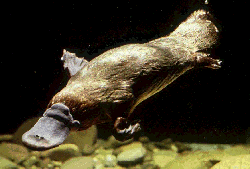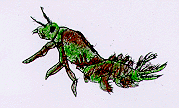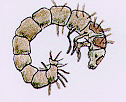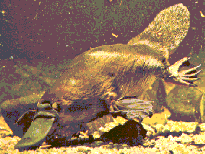
|
|

|
The platypus's diet consists of yabbies(various insect
larvae), shrimp, crayfish, earth worms, meal worms, May
flies, dragonflies, mussels, trout eggs, frog eggs,
tadpoles, small frogs and fish. The platypus
searches for its food by diving to the bottom of
streams and rocking its head from side-to-side through
the mud. These dives last for about 40
seconds. When forging on the bottom, the platypus
swims with its eyes, ears, and nostrils closed. It
uses its electro-sensitive bill to locate and probe for
food. The platypus locates its prey underwater by
sensing the electric current created by the prey's
muscle movements. This is why the platypus is such
an excellent hunter at night or in murky water.
      Normally the platypus eats up to half of its own body weight. It takes up to twelve hours to collect this amount of food. In the summer the platypus is likely to eat even more than this and stores the extra fat in its tail. This stored fat is used as a food supply when additional food is needed in the winter or for extra energy during the breeding and incubating season. Even during the winter when it is cold, the platypus still goes swimming for food. During the winter period a platypus generally eats 18% fresh water shrimp, 4% caddis fly larvae, 12% fly larvae, 18% May fly larvae, 17 % Horsehair worms, and 1% small snails daily. In the summer it generally consumes 64% caddis fly larvae, 18% fly larvae, 9% stone-fly larvae, and 9% dragon fly larvae. Several animals prey on the platypus. These include foxes, crocodiles, birds of prey, goannas, carpet pythons, large fish, cats, dogs, and dingos. Water rats sometimes kill the young platypuses in the nesting burrow. Also floods sometimes claim the lives of young platypuses. Other factors that kill platypuses are water pollution, crab pots, and fishing nets. Due to the fact that the platypus is specially adapted to its freshwater environment, the greatest danger to it is the deterioration of its living environment by humans and population growth. |

|
DESCRIPTION |
|
ATTRIBUTES |
|